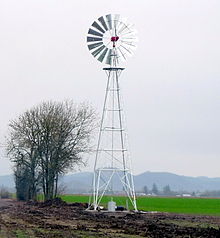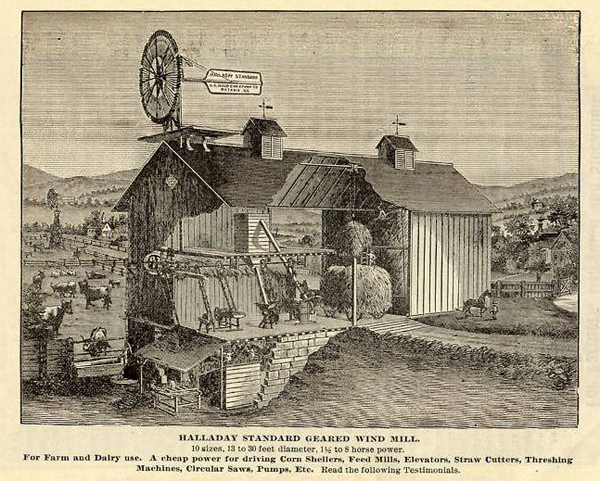
“Windmills were used to pump water since at least the 9th century in what is now Afghanistan, Iran and Pakistan. On US farms, particularly on the Great Plains, windpumps (water-pumping windmills) were used to pump water from farm wells for cattle. At their peak in 1930, an estimated 600,000 units were in use, with capacity equivalent to 150 megawatts. The multi-bladed wind turbine atop a lattice tower made of wood or steel hence became, for many years, a fixture of the landscape throughout rural America. These mills, made by a variety of manufacturers, featured a large number of blades so that they would turn slowly with considerable torque in low winds and be self-regulating in high winds. A tower-top gearbox and crankshaft converted the rotary motion into reciprocating strokes carried downward through a rod to the pump cylinder below. Rising energy costs and improved pumping technology are increasing interest in the use of this once declining technology.
A 16 ft (4.8 m) diameter wind pump can lift up to 1600 US gallons (about 6.4 metric tons) of water per hour an elevation of 100 ft with a 15 to 20 mph wind (24–32 km/h), according to a modern manufacturer. A properly designed wind pump begins working in a 3-4 mph (5 to 6.5 km/h) wind. Wind pumps require little maintenance, only a change of gear box oil annually. An estimated 60,000 wind pumps are still in use in the United States. They are particularly attractive for use at remote sites where electric power is not available and maintenance is difficult to provide.”

Source: Wiki Windpumps
Aermotor Windmills (the only US windmill manufacturer)
Image #2 source: Iron Man Windmill Co.
Home Power.com articles: Siting your Windmill,
Pumping Water with the Wind “There’s no need to reinvent the water-pumping windmill. It’s a workhorse that has been mostly unchanged since before World War II. About one million windmills are pumping water in the world today. The most common application is to install a windmill directly over a drilled or dug well. Pumping water from an aboveground source is also an easy task for a windmill. If you need to pump water on your property and the site has access to reliable winds, a water-pumping windmill may be a good option.”

Hello, This is very interesting, You’re a very skilled blogger. I’ve joined onto your site and look forward to seeking more of your excellent post. Also, I have shared your web site in my social networks! Thank you, so much!
I just learned here of EMAS site. Wow! Terrific. They will become one of my favorites.
I thought about writing you on this, but then figured you’d see it soon enough. These pumps are ingenious, eh?. I met with a director of a small, local tech school today and he seemed very interested in these pumps. He said there’s a local community who could probably benefit from these pumps. They have wells but no pumps. The director liked the treadle version, because that would allow old people to operate the pump.
PVC pipe is really cheap. Student labor is free or virtually free. They might be able to get scrap pipe from plumbers for the small pieces. Maybe they’ll charge a token amount for tools, glue and related expenses. The final cost should be far lower than any other comparable pump. Similar pumps for developing countries go for around $100 last I checked.
Nice post on windmills Owen,
I might add Ive grown up with them all my life,
and will tell you that the idea that you only need
some machine oil yearly and all is well is a stretch.
In my experience,as well as the 3 generations before me,
you better be prepared to disassemble the gear box,have
extra parts on hand. They are in constant need of maintenance.
Oiling,greasing…two much wind and you have problems with blowing
out gears, to little wind and no water. Keeping the rubbers in them greased is
a must. Youll lose pressure and no water if they crack and dry. Windmills are a great idea for certain parts of the world,and they have been used by my forefathers for water. All thatbeing said is they do take alot of work and maintaining. Its not a set it and forget it option. I personally prefer solar pumps and the cost of a solar pump with panels is equal to that of a windmill. The point is look at ones surroundings,depth of water and determine what fit is best for YOU. Thanks for the post as always!
Thanks for your opinion. It’s always good to hear different viewpoints.
Windmills are cool, but they may not be as maintainence free as some suggest. In my area I would say 90% of the windmills have been replaced with solar. I asked a neighboring rancher about the one he replaced. He said the mechanical ones were labor intensive and expensive to repair. Most of the ranchers who took their windmills down, sold them as lawn ornaments to people who liked the way they look.
Most in the area are pumping water from around 500-600 ft.
That’s interesting. This confirms what Rex just said.
Suggestion for a follow up blog post:
Build your own pump for just a few bucks.
http://vimeo.com/8366584
Build your own turbine to power one of those pumps.
http://vimeo.com/8367311
Those EMAS pumps are beautiful in their simplicity.
EXCELLENT find, Jay!!!
EMAS has a whole bunch of great videos demonstrating a plethora of extremely inexpensive DIY technologies they promote in Bolivia.
That same EMAS Vimeo account has many other excellent videos.
They have other styles of water pumps.
The video I linked to above demonstrates their “High Capacity” water pump. Useful for pumping a lot of water quickly but only lifting it from a fairly shallow depth.
EMAS also has another version of the same basic concept, but is a “high pressure” pump. Useful for pumping from deep wells, but it won’t lift as high a quantity of water as quickly.
There also is a “standard” pump that is in a middle range.
Also worth checking out is their amazing rig for drilling your own water well by hand using homemade equipment. Equipment that could get carried to a remote site on the backs of a handful of helpers, on a mule or two, or in the back of a small pickup truck (with room to spare).
They also show how to make ferrocement water storage tanks/cisterns/sinks, water filters, etc.
I also love their videos teaching how to make your own extremely inexpensive PVC elbows, tee’s, and other fittings from just a few lengths of standard pipe. PVC pipe is very cheap, but the fittings can be outrageous!!
It’s a completely DIY water handling system for minimal expense.
They are doing some amazing work there. I’m a huge fan.
All coming from their headquarters/training center on the shores of Lake Titicaca where they hold classes teaching local Bolivians how to make all this stuff for themselves. How awesome is that? Gives me hope that there is some decency left in humanity.
Give a man a fish, he eats for a day.
Teach him to fish, he eats for a lifetime.
Give a man a pump, he can lift water for a few years until the pump breaks.
Teach a man how to build his own pump, and he will bring clean water to himself, his family, and his surrounding community, for the rest of his life. Plus he will teach future generations how to build and maintain that legacy beyond his lifetime.
No broken EMAS pump/cistern/filter will ever need to be replaced by a foreign aid organization. The locals will know how to repair and maintain it themselves.
It’s an extremely powerful society altering technology.
Something worth copying and sharing with other societies.
Sounds like a great group. I may present this to a local tech college and see if they’re interested in building one. The cost should be extremely low. It’s mostly labor. I’d like to see this technology spread in this area.
If they take it on, I hope you will shoot some video and post some updates.
Not just of them copying what EMAS has demonstrated, but how locals in your area change and adapt the technology to their own local geographical conditions and societal traditions. I’m certain the folks in Bolivia would love to see what you accomplish as well.
I just met the director the other day and he seemed interested in collaborating on projects. It seems like he wants to try new things. See what happens. But it would likely take a long time before any new designs were developed. Their emphasis is on teaching practical skills and making marketable products, not innovation.
Now we’re talking h2O….
Sometimes the simplest, most practical solutions are all around us. These water pumping windmills are ubiquitous in some areas.